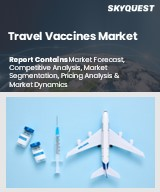
|
시장보고서
상품코드
1572448
E형 간염 진단 테스트 시장 : 기회, 성장 동인, 산업 동향 분석 및 예측(2024-2032년)Hepatitis E Diagnostic Tests Market, Opportunity, Growth Drivers, Industry Trend Analysis and Forecast, 2024-2032 |
||||||
세계 E형 간염 진단 검사 시장은 2023년 약 6,000만 달러로 평가되었습니다.
2024년부터 2032년까지 4.3%의 연평균 복합 성장률(CAGR)로 성장률을 나타낼 것으로 예측됩니다. 전 세계적으로 E형 간염 환자가 급증하면서 효율적인 진단 솔루션에 대한 수요가 증가하고 있으며, E형 간염 바이러스(HEV)는 E형 간염의 원인으로, 특히 개발도상국의 열악한 위생 환경과 오염된 수자원으로 인해 그 유행이 증가하고 있습니다. 세계보건기구(WHO)의 보고에 따르면, 전 세계적으로 연간 약 2,000만 건의 E형 간염 바이러스 감염이 발생하고 있으며, 약 330만 명의 유증상 환자가 발생하고 있습니다. 이러한 유병률 증가는 신뢰할 수 있는 진단 검사에 대한 긴급한 필요성을 부각시키며 시장 확대의 원동력이 되고 있습니다.
인식 제고와 종합적인 검진 프로그램은 시장 성장을 가속하는 데 매우 중요합니다. 공중 보건 노력과 교육 캠페인은 E형 간염에 대한 인식을 높이고 더 많은 사람들이 검사를 받도록 장려하고 있습니다. 특히 고위험 지역에서는 검진 강화로 질병을 더 잘 발견하고 관리할 수 있게 되었습니다. 이러한 노력은 조기 진단을 촉진하고 간염의 확산을 모니터링하고 확산을 억제하는 데 도움이 되고 있습니다.
E형 간염 진단 검사 시장은 검사 유형, 샘플 검사, 최종 용도 및 지역에 따라 분류됩니다.
검사 유형에 따라 ELISA HEV IgM 검사, ELISA HEV IgG 검사, 신속 진단 검사, 중합효소연쇄반응(PCR)으로 구분되며, ELISA HEV IgM 검사 분야는 2032년까지 4,470만 달러 규모에 달할 것으로 예상됩니다. 이 검사는 감염 발생 직후에 나타나는 IgM 항체를 검출하여 최근 HEV 감염을 식별할 수 있다는 점에서 중요하며, 전 세계적으로 E형 간염에 대한 인식과 스크리닝이 증가함에 따라, 특히 유병률이 높은 지역에서 ELISA HEV IgM 검사와 같은 적시 진단 도구에 대한 수요가 증가할 것으로 예상됩니다. 수요가 증가할 것으로 예상됩니다. 또한, 검사 민감도 및 특이도 향상과 바이러스성 간염 퇴치를 위한 공중보건 예산 증가가 이 부문의 성장에 기여하고 있습니다. 이러한 추세는 E형 간염 발병을 관리하기 위한 조기 진단 및 개입의 중요성을 강조하며 시장 확대의 원동력이 되고 있습니다.
샘플 유형에 따라 E형 간염 진단 테스트 시장은 혈액과 대변으로 나뉘며, 2023년 혈액 부문 매출은 5,110만 달러였습니다. 혈청학적 분석 및 분자 검사를 포함한 혈액 기반 진단은 HEV 항체 및 RNA를 검출하는 능력으로 높은 평가를 받고 있습니다. 이 정확도는 질병 진단 및 모니터링에 매우 중요합니다. 이러한 인기는 효과적인 관리에 필수적인 급성기 및 만성기 감염을 모두 감지할 수 있다는 점에서 기인합니다. 높은 민감도와 특이성 등의 장점으로 인해 혈액 검사는 신뢰할 수 있는 것으로 간주되어 의료 전문가들 사이에서 선호되고 있습니다. 그 결과, 혈액 기반 부문은 E형 간염의 정확한 진단에 있어 핵심적인 역할을 반영하여 계속해서 시장을 지배하고 있습니다.
미국 E형 간염 진단 검사 시장은 2032년까지 3,420만 달러에 달할 것으로 예측됩니다. 주요 촉진요인으로는 진단의 기술적 진보와 현장 진료 검사 증가를 들 수 있습니다. 분자진단 및 첨단 분석법 등 기술 혁신으로 E형 간염의 검출 정확도와 속도가 향상되고 있습니다. 동시에 신속 검사 및 현장 검사가 가능해짐에 따라 이러한 진단이 임상에서 보다 쉽게 이용할 수 있게 되었습니다. 이러한 기술 발전은 진단 능력을 향상시키고 보다 신속하고 효율적인 검사를 촉진하여 시장 성장을 크게 견인할 것으로 예상됩니다.
목차
제1장 조사 방법과 조사 범위
제2장 주요 요약
제3장 업계 인사이트
- 생태계 분석
- 업계에 대한 영향요인
- 성장 촉진요인
- 업계의 잠재적 리스크&과제
- 성장 가능성 분석
- 규제 상황
- 기술 전망
- 코어 기술
- 인접 기술
- 향후 시장 동향
- 갭 분석
- Porter's Five Forces 분석
- PESTLE 분석
제4장 경쟁 구도
- 서론
- 기업 점유율 분석
- 기업 매트릭스 분석
- 주요 시장 기업 - 경쟁 분석
- 경쟁 포지셔닝 매트릭스
- 전략 대시보드
제5장 시장 추산·예측 : 검사 유형별, 2021년-2032년
- 주요 동향
- ELISA HEV IgM 검사
- ELISA HEV IgG 검사
- 신속 진단 검사
- 중합효소 연쇄반응(PCR)
제6장 시장 추산·예측 : 샘플 유형별, 2021년-2032년
- 주요 동향
- 혈액
- 변
제7장 시장 추산·예측 : 최종 용도별, 2021년-2032년
- 주요 동향
- 병원
- 진단 실험실
- 혈액은행
- 기타 최종사용자
제8장 시장 추산·예측 : 지역별, 2021년-2032년
- 주요 동향
- 북미
- 미국
- 캐나다
- 유럽
- 독일
- 영국
- 프랑스
- 스페인
- 이탈리아
- 네덜란드
- 기타 유럽
- 아시아태평양
- 중국
- 일본
- 인도
- 호주
- 한국
- 기타 아시아태평양
- 라틴아메리카
- 브라질
- 멕시코
- 아르헨티나
- 기타 라틴아메리카
- 중동 및 아프리카
- 남아프리카공화국
- 사우디아라비아
- 아랍에미리트(UAE)
- 기타 중동 및 아프리카
제9장 기업 개요
- altona Diagnostics GmbH
- CTK Biotech, Inc.
- Dia.Pro Diagnostic Bioprobes s.r.l
- DiaSorin S.p.A.
- ELITechGroup(Bruker company)
- F. Hoffmann-La Roche Ltd
- Fortress Diagnostics
- Genscript Biotech Corporation
- Guangzhou Wondfo Biotech Co., Ltd.
- Medsource Ozone Biomedicals Pvt. Ltd.
- MIKROGEN GmbH
- MP Biomedicals
- Primer Design
- Wantai BioPharm
The Global Hepatitis E Diagnostic Tests Market was valued at approximately USD 60 million in 2023. Projections indicate a growth rate of 4.3% CAGR from 2024 to 2032. The global surge in hepatitis E cases has increased the demand for efficient diagnostic solutions. The hepatitis E virus (HEV) is the culprit behind hepatitis E, with its prevalence rising due to poor sanitation and tainted water sources, notably in developing areas. The World Health Organization (WHO) reports that around 20 million global infections of the hepatitis E virus occur annually, leading to roughly 3.3 million symptomatic cases. This rising incidence highlights the urgent need for dependable diagnostic tests, driving market expansion.
Heightened awareness and comprehensive screening programs are pivotal in driving market growth. Public health initiatives and educational campaigns have shed light on hepatitis E, encouraging more individuals to pursue testing. Enhanced screening initiatives, especially in high-risk regions, bolster the detection and management of the disease. These efforts promote early diagnosis and help monitor prevalence and curb the spread of hepatitis.
The Hepatitis E Diagnostic Tests Market is grouped based on test type, sample test, end-use, and region.
The market is segmented by test type into ELISA HEV IgM test, ELISA HEV IgG test, rapid diagnostics test, and polymerase chain reaction (PCR). The ELISA HEV IgM test segment will reach USD 44.7 million by 2032. The test is significant because it identifies recent HEV infections by detecting IgM antibodies, which appear shortly after infection onset. As global awareness and screening for hepatitis E increase, especially in high-prevalence regions, the demand for timely diagnostic tools like the ELISA HEV IgM test will rise. Additionally, advancements in test sensitivity and specificity, along with increased public health funding for viral hepatitis control, contribute to this segment's growth. This trend underscores the importance of early diagnosis and intervention in managing hepatitis E outbreaks, driving market expansion.
Based on sample type, the hepatitis E diagnostic tests market is divided into blood and stool. In 2023, the blood segment generated USD 51.1 million. Blood-based diagnostics, including serological assays and molecular tests, are highly valued for their ability to detect HEV antibodies and RNA. This precision is crucial for diagnosing and monitoring the disease. Their popularity stems from their ability to detect infections in both acute and chronic stages, which is essential for effective management. With advantages like higher sensitivity and specificity, blood tests are considered reliable, making them the preferred choice among healthcare professionals. Consequently, the blood-based segment continues to dominate the market, reflecting its central role in accurately diagnosing hepatitis E.
In the U.S., the hepatitis E diagnostic tests market is projected to reach USD 34.2 million by 2032. Key drivers include technological advancements in diagnostics and the rise of point-of-care testing. Innovations such as molecular diagnostics and advanced assays are enhancing the accuracy and speed of hepatitis E detection. At the same time, the growing availability of rapid and point-of-care tests is making these diagnostics more accessible in clinical settings. This technological progress is expected to drive substantial market growth by improving diagnostic capabilities and facilitating quicker, more efficient testing.
Table of Contents
Chapter 1 Methodology and Scope
- 1.1 Market scope and definitions
- 1.2 Research design
- 1.2.1 Research approach
- 1.2.2 Data collection methods
- 1.3 Base estimates and calculations
- 1.3.1 Base year calculation
- 1.3.2 Key trends for market estimation
- 1.4 Forecast model
- 1.5 Primary research and validation
- 1.5.1 Primary sources
- 1.5.2 Data mining sources
Chapter 2 Executive Summary
- 2.1 Industry 360° synopsis
Chapter 3 Industry Insights
- 3.1 Industry ecosystem analysis
- 3.2 Industry impact forces
- 3.2.1 Growth drivers
- 3.2.1.1 Rising hepatitis E incidence
- 3.2.1.2 Advancement in diagnostic technologies
- 3.2.1.3 Rising awareness and screening programs
- 3.2.2 Industry pitfalls and challenges
- 3.2.2.1 Limited availability in developing regions
- 3.2.2.2 Stringent regulatory scenario
- 3.2.1 Growth drivers
- 3.3 Growth potential analysis
- 3.4 Regulatory landscape
- 3.5 Technology landscape
- 3.5.1 Core technologies
- 3.5.2 Adjacent technologies
- 3.6 Future market trends
- 3.7 Gap analysis
- 3.8 Porter's analysis
- 3.9 PESTLE analysis
Chapter 4 Competitive Landscape, 2023
- 4.1 Introduction
- 4.2 Company market share analysis
- 4.3 Company matrix analysis
- 4.4 Competitive analysis of major market players
- 4.5 Competitive positioning matrix
- 4.6 Strategy dashboard
Chapter 5 Market Estimates and Forecast, By Test Type, 2021 - 2032 ($ Mn)
- 5.1 Key trends
- 5.2 ELISA HEV IgM test
- 5.3 ELISA HEV IgG test
- 5.4 Rapid diagnostics test
- 5.5 Polymerase chain reaction (PCR)
Chapter 6 Market Estimates and Forecast, By Sample Type, 2021 - 2032 ($ Mn)
- 6.1 Key trends
- 6.2 Blood
- 6.3 Stool
Chapter 7 Market Estimates and Forecast, By End-use, 2021 - 2032 ($ Mn)
- 7.1 Key trends
- 7.2 Hospitals
- 7.3 Diagnostic laboratories
- 7.4 Blood banks
- 7.5 Other end-users
Chapter 8 Market Estimates and Forecast, By Region, 2021 - 2032 ($ Mn)
- 8.1 Key trends
- 8.2 North America
- 8.2.1 U.S.
- 8.2.2 Canada
- 8.3 Europe
- 8.3.1 Germany
- 8.3.2 UK
- 8.3.3 France
- 8.3.4 Spain
- 8.3.5 Italy
- 8.3.6 Netherlands
- 8.3.7 Rest of Europe
- 8.4 Asia Pacific
- 8.4.1 China
- 8.4.2 Japan
- 8.4.3 India
- 8.4.4 Australia
- 8.4.5 South Korea
- 8.4.6 Rest of Asia Pacific
- 8.5 Latin America
- 8.5.1 Brazil
- 8.5.2 Mexico
- 8.5.3 Argentina
- 8.5.4 Rest of Latin America
- 8.6 Middle East and Africa
- 8.6.1 South Africa
- 8.6.2 Saudi Arabia
- 8.6.3 UAE
- 8.6.4 Rest of Middle East and Africa
Chapter 9 Company Profiles
- 9.1 altona Diagnostics GmbH
- 9.2 CTK Biotech, Inc.
- 9.3 Dia.Pro Diagnostic Bioprobes s.r.l
- 9.4 DiaSorin S.p.A.
- 9.5 ELITechGroup ( Bruker company)
- 9.6 F. Hoffmann-La Roche Ltd
- 9.7 Fortress Diagnostics
- 9.8 Genscript Biotech Corporation
- 9.9 Guangzhou Wondfo Biotech Co., Ltd.
- 9.10 Medsource Ozone Biomedicals Pvt. Ltd.
- 9.11 MIKROGEN GmbH
- 9.12 MP Biomedicals
- 9.13 Primer Design
- 9.14 Wantai BioPharm



















